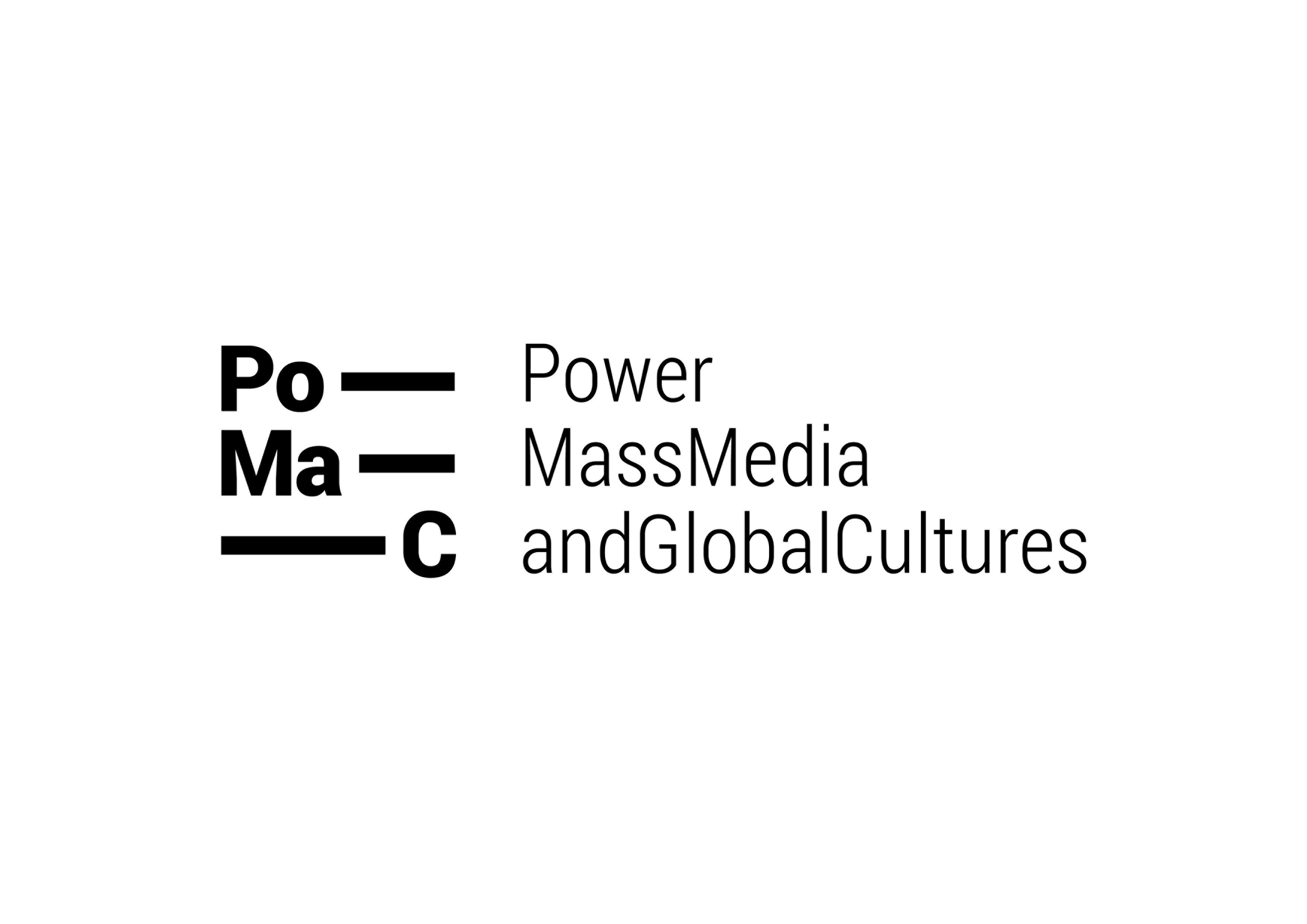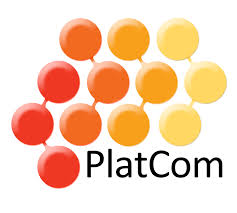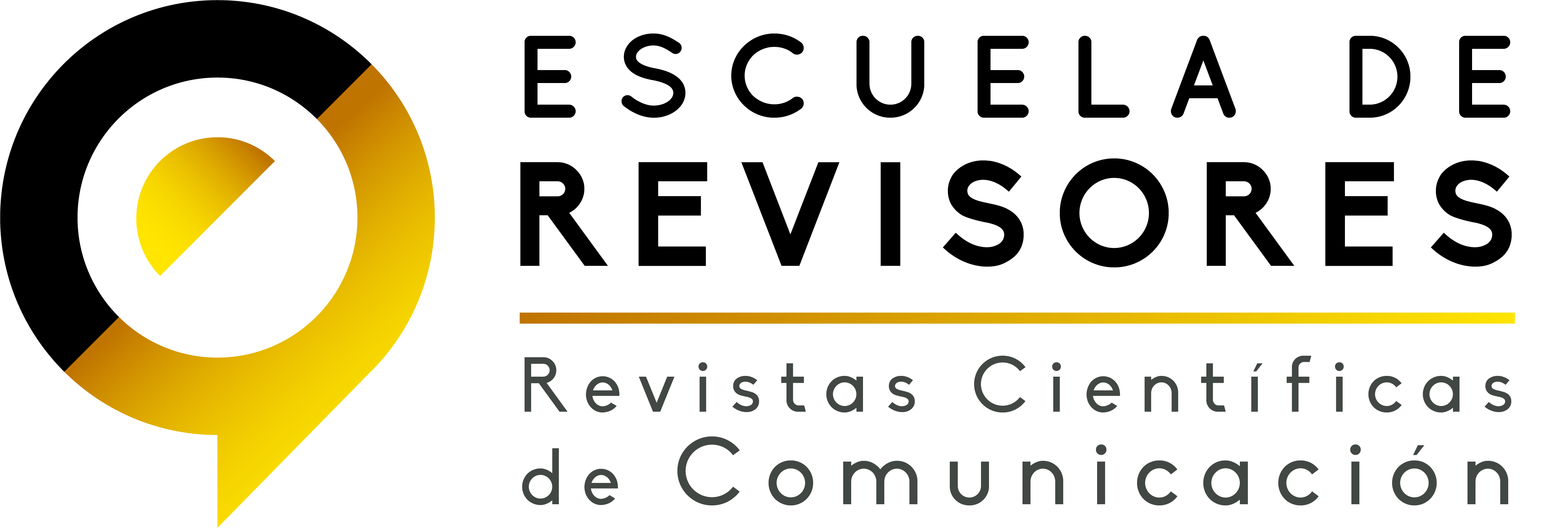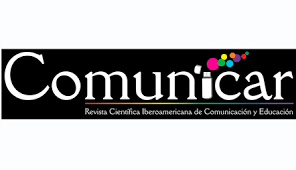Submissions
Submission Preparation Checklist
As part of the submission process, authors are required to check off their submission's compliance with all of the following items, and submissions may be returned to authors that do not adhere to these guidelines.- The submission has not been published before or has been submitted to any other magazine (or an explanation was sent to 'Comments for the publisher').
- The file of the submission is in document format of OpenOffice, Microsoft Word, RTF or WordPerfect.
- Whenever possible, the URLs for the references have been provided.
-
The text uses a single spacing, font size 12 and italics, rather than underlining, except URLs. As for all the illustrations, figures and tables, they are placed in the corresponding place of the text and not in the end.
- The text complies with the stylistic and bibliographic requirements described next, which are found in «About this journal».
Author Guidelines
Guidelines to publish in Communication Papers (version passed in the PlatCom General Assembly, May 2014)
Structure:
I. Guidelines for manuscripts
II. Additional information (publication ethics and assignment of rights)
I. GUIDELINES FOR MANUSCRIPTS
I.0. Style guidelines:
Original manuscripts are to be sent onto the platform following these style guidelines:
- All the files are to be sent in Word format ‘.doc’ or ‘.dox’.
- 12-point Arial font, 1.0-line spacing.
- Titles of sections and subsections in 14-point Arial font, 1.0-line spacing and bold letters.
- Images and tables are to be included in the corresponding section in the body of text, with
title and source.
I.1. Contents:
Type of manuscripts: manuscripts will be considered for publication if they present
results of research into any field related to Social Communication Sciences. Those manuscripts
tackling aspects that are not so common in the literature will be prioritized, thus fostering
research lines which are newly explored or which might lead to research lines with greater
impact. State-of-the-art manuscripts or essays will be exceptionally published only if they
offer new research insights. Manuscripts previously published in conference proceedings or
which have been presented in congresses or conferences will not be published, unless 70% of
their content is new.
Manuscripts must be written in a clear and pedagogic style.
Maximum length: 6.000 words (including bibliographical references, notes and tables). Language: the texts will always be published in Spanish. Additionally, the authors may send manuscripts in the following languages: English, Portuguese, French, Italian, Galician, Catalan and Basque. In all cases, there should always be a summary in Spanish and an abstract in English, as well as the title and the keywords.
I.2. On authors:
They must be teachers or researchers, preferably Doctors or Postgraduaters. It is important for
authors to add their ORCID register number https://orcid.org as it allows keeping their identity
unchanged and contributes to a better localization of the author’s production and quotations.
No PLATCOM journal will publish articles by the same author in two consecutive.
The maximum number of authors per article is 3. If it is a research study in which more than 3
people have collaborated, the rest of authors will appear as collaborators from the third
author on.
Any collaborator (translator, statistician, research assistant staff, funding sources…) who have
contributed partially in the text or who have facilitated the research tackled in the article will
be mentioned in the acknowledgements section.
Degree of editorial endogamyi: only 20% of the articles published in each issue per year can be linked to the Scientific Committee and to the Publishing Committee.
Degree of university endogamyi: only 20% of the articles published can be by an author from the same university of that of the Director, Editor or Coordinador of this journal.
I.3. MANUSCRIPTS.
For the journals with no working template, the structure of the manuscripts will be as follows:
1. Title. In the original language of the article and, in any case, Spanish and English. Only two levels of titles will be admitted as long as they are specified properly. In capital and lowercase font. Short, clear, concise, informative, without question marks or interjections, consisting of just one sentence, if posible, without quotation marks, with no full stop.
2. Authors.
2.1 Academic title. Dr./Dra., DEA., Ddo/a., Lic., Mgter., Mtro/Mtra., Mdo/a.
2.2 Academic Position: Lecturer (Professor, Assistant Professor, Adjunct), Researcher, Research Assitant, PhD Student.
2.3 Full name and SURNAMES. ORCID url (http://orcid.org/0000-0xxx-xxxx[1]xxxx)
2.4 Institutional affiliation in full: Department. Faculty. University. Country. Work postal address, postal code, town, region, country, telephone.
2.5 Institutional email, preferably.
2.6 Academic, professional and disseminating social networks of the author(s) so they can be found by readers.
3. Summary and abstract. In the original langauge and, in any case, Spanish and English, between 200 and 225 words. In just one paragraph. With the following structure: justification of the topic at work, objectives, research methodology, results and conclusions. Next, the abstract, which will be the translation of the summary into English. Proposal, method, findings,
limitations, and original contribution in the text.
4. Keywords. 6 keywords maximum in the original language and, in any case, in Spanish and English. In alphabetical order and between “;”. They will be terms that are frequently used, well-chosen and specific. Next to these, the translation of these keywords into English.
5. Acknowledgements and funding sources. the authors will be able to express their acknowledgement to those who deserve their recognition or to the funding sources as long as they are not their own university (indicating name of project/grant, initial and final year, original research title and reference)
6. Structure of the article following the pattern (IMRD1+C y B: Introduction +
Methodology + Results + Discussion + Conclusions and Bibliographical references):
6.1 Introduction. It will consist in the purpose of the research, its objectives, and the definition of the research problem, its relevance and the state of the art of the topic at work. It will present the contributions from other relevant research studies and will highlight those on which it is based to define the objectives and the research hypotheses, which will be clear and precise –unless it is an exploratory piece of research, without prior investigation – and it will be properly reasoned. Purpose, objectives, problem, relevance, state of the art, contributions,
hypotheses and justification.
6.2 Method or methodology. The method followed will be presented and the choice and design of the methodological tools will be explained. If needed, the subjects and the sample selected as well as the system chosen to obtain the units of analysis will also be indicated. The instrument chosen to obtain the sample will also be referred to, and its reliability and scientific validity will be stated, giving grounds as to why it was chosen. Supposing the study presents a brand new system, its features will have to be explained. The variables will be defined properly. Method, design, target population, sample, units of analysis, instrument, reliability,
units of analysis, reasoning, and if needed, explanation. This is needed to be able to replicate the study.
6.3 Results. Presentation of the findings in a concise, brief, precise, ordered way, with the appropriate statistical terms. No quotations in this section. Expose the Reliability of the findings.
6.4 Discussion. Discuss the results and state if they answer the research questions, correlating the results with the hypotheses. Use present tenses. Compare with previous results in similar research studies. Authenticity of the results, internal validity, generalization of the
data and possible limitations of the study.
6.5 Conclusions. They derive from the results exclusively and are a synthesis from them, stated clearly and briefly.
Recommendations
1)Hill et al., citado por Swales, J. M. (1990). Genre Analysis. Cambridge: Cambridge University Press.
for the theory and the practice will be provided as well as suggestions for further research.
6.6 Bibliographical references. Relevant bibliography, complete and up-to[1]date, without notable absences nor clear obsolescence. Avoid superfluous references. Bibliography (10-7-5-2): There will be at least 10 bibliographical references. 70% of the references will be of the last 10 years, except for those topics which make it unadvisable. At least 50% of the references will be of academic journals, excepting those cases where the topic is so original that no relevant research into it has been published yet. Up to 20% of self-citation will be accepted, maximum 3 citations, only of published texts. Only those bibliographical references cited in the body of the article will be included. In addition, if the topic requires it, part of the references will be in English.
7. Text. No text in bold letters or underlined. Italics will be used when needed. Simple quotation marks (‘ejemplo’) can be used to mention book titles, newspapers, magazines, etc. The paragraphs will not exceed 10 lines and will not be indented.
8. Notes. As they can hinder the reading pace, using footnotes is not advisable unless using them is essential to clarify relevant aspects. When footnote are needed, they will appear numbered consecutively, they will appear at the end of the article, before the references. The word ‘Notes’ will be written at the end of the text, before the bibliography, with the corresponding epigraph number, for example, 8. Notes.
9. Quotes in the text. All the data and ideas taken from another author must be referenced so as to avoid plagiarism and rejection of the text submitted. The quotations must be justified and relevant. Irrelevant and nonsensical quotes will be avoided.
9.1 Quotations of 40 or fewer words will be inserted in the text, between quotation marks and without italics: “quotation”. If there was a quotation within another quotation, it will be indicated as follows “primary ‘secondary quotation’ quotation”.
9.2 The quotations over 40 words will appear in a different paragraph, indented on both the right and the left sides, with one tab space. In addition, these quotations longer than 40 words will be in a smaller font and without quotation marks or italics.
9.3 It is recommended that the quotation within the text follow the Harvard system or parenthetic (Author, year: page). Example: (García, 2001: 34). (García, 2001: 34-37) will be used when more than one page is referred to. Letters (a, b, c…) are used to distinguish different studies by the same author in the same year. In contextual quotations, the page number can be omitted. The text quoted must remain unaltered. If part of the quotation is
omitted, it will be indicated within the quotation with square brackets and ellipsis within: […]. If the quotation is shortened at the beginning or at the end, ellipsis must be put either before or after the initial quotation marks at the beginning or at the end –respectively–. If there was a clear mistake, it should be left as in the original and it should be noted: (sic).
9.4 All the works cited must appear in the References section. No new ideas will be attached to authors who have not stated them themselves and quotations must not be misinterpreted. If a
quotation longer than 10 lines is needed, the author will need to show the approval from the author cited. If a quotation is in a different language from the one of the manuscript, it must be left in the original language and it can be translated between parentheses or in a footnote.
10. Bibliographical references. It is recommended to follow the norms established by the American Psychological Association (APA) (last edition).The bibliographical references that appear in the text of the article must appear at the end of the article in the “Bibliographical references”. They must be presented in alphabetical order and numbered correlatively as follows: [1]; [2]; [3]... They must start with the authors’ surname or the name of the institution. If the book title has a subtitle, it must be separated from the title with a period. To see examples of each source cited, visit this link.
11. Tables, graphs, illustrations, figures and images must be readable, editable, elaborated with Office preferably – or in the original version of the application used– pasted in the appropriate place within the text, numbered correlatively following their own order, preceded by a title (descriptive, short, no longer than one line) and referencing the source in the lower margin. If needed, the author will be asked to send the original version of the images, preferably with .jpg .png .tiff or .giff extensions and 300ppp of resolution and editable (in the same file of the program used to make them). It is recommended not to overuse these resources and eliminate those that can be omitted.
12. Videos. Videos can be included in articles so as to enhance the multimedia elements of the journal, but the maximum number is 3 per article. The videos (for example, interviews, conferences, etc.) must be originally from the author of the article or will have had to obtain the permission of its authors. They will be referenced via hyperlinks in the text. It is recommended that they are no more than 10 minutes long.
13. Appendices.
14. Curriculum vitae. 100 words maximum, as in a mini-biography.
I.4. Reviews
The reviews must be unpublished, original and cannot have been submitted to any
other journal for publication. It is recommended that they have their original title, different from that of the work reviewed.Reviews will be accepted mainly if they are of books and articles, but also of reports, teaching materials, working documents, meetings, conferences, forums, news items related to the topics of each journal and other similar initiatives. All of them must be of works recently published (last 2 years) and of scientific interest in the Communication field.
Maximum length: 2,000 words.
In addition, an image of the cover will be attached in .jpg / .png format, 300ppp.
The review will consist of three parts:
a. Bibliographical data of the work reviewed:
• Complete title of the work reviewed;
• Author, authors, coordinators or editors;
• City of publication;
• Publishing house;
• Year;
• Number of pages;
• ISBN, ISNN; DOI;
• Original title of the review.
b. Comments by the reviewer:
• Description of the type of work (if it is academic, teaching material, , a
piece of research, etc.);
• How it is divided (in blocks, chapters…);
• If it has bibliography, graphs or any other type of illustrations;
• Summary of the work reviewed and of its main points of interest;
• Evaluation of the strengths and weaknesses of the work reviewed;
• Comments about its innovative character or new approach developed in it;
• Critical assessment addressing specific paragraphs, parts of the work or
textual citations that support what has been exposed by the author.
• It would be interesting if it was stated if the author has accomplished their
main;
• Mention the target audience (researchers, professionals, students,
teachers, etc.);
• Comment about the interest that this work has for the intended audience;
• If the review includes bibliographical references, they should folllow the
APA style (last edition).
c. Personal information of the review author:
• Reviewed by: Name and surnames of the author of the review; Academic
degree; Job position, Institutional affiliation and acronym; Country,
Contact e-mail.
II. Additional documents
II.1. Ethics
The authors, when submitting their manuscript, state their moral and ethic responsibility with
the following implications:
• They have carried out a piece of research:
o Consistent and reliable, responsible and legal, carefully elaborated, using the appropriate methods of analysis, thus guaranteeing, the results…
o Honest: without lying or falsifying or manipulating data.
o Original: subject to the laws of intellectual property, citing identifiable primary sources.
o Transparent with the research funding sources, including the direct and indirect financial support, the supply of equipment or material or any other type of support. o Unpublished: it has not been published before, neither totally nor partially, in any other media, country or language; it has not been submitted simultaneously to any other journal without the prior consent of co[1]publishing, stating it in the text.
• They are responsible for the contents. Neither PlatCom nor the journal is to be held responsible for the ideas or opinions stated by the authors.
• They have contributed to the conception, design, and elaboration of the research, analysis and interpretation of the data, and have participated in the writing process and its revisions as well as in the approval of the version to be published
• They accept the introduction of changes in the contents of the text after the revision and changes in the style of the manuscript on behalf of the journal publishing team, accepting the publishing guidelines and evaluation of the journal. They must commit themselves to make the changes needed within the period established. Likewise, they must communicate their refusal for their article to be reviewed as soon as possible if needed.
• They are aware that the publication of the text in any of the PlatCom journals will not be remunerated.
• They do not hold any personal or commercial deal that can cause any conflict of interests in relation to the text submitted, and they have to have respected all ethical research principles.
Remarks about co-authorship. The degree of participation in the research will depend on the
simultaneous presence of these conditions: the intervention in all the phases (structure, composition and revision), the coordination with the rest of authors, the contribution to obtaining funding, the data compilation and analysis. The order of authors will be previously agreed upon. The author takes public responsibility for the contents of the article. The researchers with minor contributions must only appear in the acknowledgements. Ethical commitment from the editors, members of the committees and reviewers [RMC, Fonseca and Communication Papers].
The editors of the journals as well as those responsible for PlatCom certify that the names and e-mail addresses introduced in this journal will be exclusively used for the purposes stated by both PlatCom and the journal and will not be available for any other purpose. Only when the manuscript is accepted will the e-mail addresses be published for possible interactions between the authors and the readers. PlatCom, following the recommendations of the main international organizations, such as Committee on Publication Ethics (Cope), deems it necessary and important to promote ethical publications and takes into consideration the following ethical principles in all the editorial process:
• The freedom of expression of the authors, catering for diversity and for minorities.
• The freedom of editorial decision ultimately corresponds to the editor, once thereports from the reviewers have been read. The freedom to decide to publish amanuscript or not lies on the editor, having seen the reports from the evaluators. Eachjournal has public instructions as to how to proceed when not agreeing with theeditor’s decision.
• The balance in gender in the composition of all the different journal boards.
• The journals with Open Journal System (OJS) are committed to ensure the accessibilityof users with only-text navigators or with help devices, activating the appropriate tools that the system offers.
• The responsibility from the editor to preserve the anonymity of the authors andreviewers during the review process.
• The confidentiality commitment of the data and of the texts from reviewers andeditors. The author’s commitment with the internationally accepted guidelines when the research involves either human beings or animals.
• The acknowledgement of conflict of interests, if needed. In these cases, the COPE flow charts will be followed.
• Manipulating quotations is discouraged.
• The editors will use mechanisms to identify plagiarism. If plagiarism is found, the author or authors will be prevented from publishing again in any of the PlatComjournals. The editor will also notify this to the Red Bogotá de Revistas Científicas deComunicación. If the text is already published, it will stay published with a watermark informing about this circumstance. The article will not be retired in any case.
• The auditable register of all the interactions.
• Where authorship is put into question, the reviewing process or the publication of the text will be suspended until it is solved.
The quality of the texts is based on the anonymous peer-review. In those cases when the editor keeps correspondence or receives the comments on articles from other professionals who are not directly linked to the review process, these can express their opinions contributing to the acknowledgement of the research contributions of what has been published.
These guidelines are an excerpt from TUR-VIÑES, Victoria; FONSECA-MORA, M. Carmen;
GUTIÉRREZ-SAN MIGUEL, Begoña (2012). “Ética de la publicación científica: iniciativas y
recomendaciones”. El profesional de la información, vol.21, September-October, n5, pp. 491-
497. http://dx.doi.org/10.3145/epi.2012.sep.07
II.2. Assignment of rights
When submitting their manuscript, the authors transfer the copyright, edition and reproduction rights as well as the research data supplied in tables or databases that have been
used to establish their conclusions to the journal and to PlatCom so they can publish the article under a Creative Commons Attribution-ShareAlike 4.0 International (CC BY-SA 4.0).
https://creativecommons.org/licenses/by-sa/4.0/
So as to make the dissemination of the texts easier and to increase the chances of citation, the texts will be disseminated via the PlatCom and/or the journal Social Networks, as well as in any other platform or dissemination system deemed appropriate. The assignment of rights reaches the media where the texts are disseminated.
Miembros PlatCom (2014)
Carmen Echazarreta Soler and Nuria Puig, from Communication Papers.
Begoña Gutiérrez San Miguel and Elena Medina de la Viña, from Fonseca.
Nekane Parejo Jiménez and Agustín Gómez Gómez, from Fotocinema.
Pedro Pérez Cuadrado and Belén Puebla Martínez, from Index.Comunicación.
José Luis González Esteban and Alicia De Lara González, from MHCJ.
Alejandro Álvarez Nobell and Ciro E. Hernández Rodríguez, from Pangea.
José Miguel Túñez López and Karina Valarezo, from Revista Ciber Comunicación.
Victoria Tur Viñes and Carmen López Sánchez, from Revista Mediterránea de Comunicación.
Jesús Miguel Flores Vivar and Cecilia Salinas Aguilar, from Tec Com Studies.
Joan Josep Matas Pastor and Llorenç Espasa, from Temps de Comunicar.
Francisco Sierra Caballero and Lucía Benítez Eyzaguirre, from Revista Redes.com.
Revista de Estudios para el Desarrollo Social de la Comunicación.
i Delgado López-Cózar, E.; Ruiz-Pérez, R. and Jiménez-Contreras, E. (2006). La edición de revistas
científicas; directrices, criterios y modelos de evaluación. Madrid: FECYT / Granada: EC3, p.75.
ii Idem., p.75






